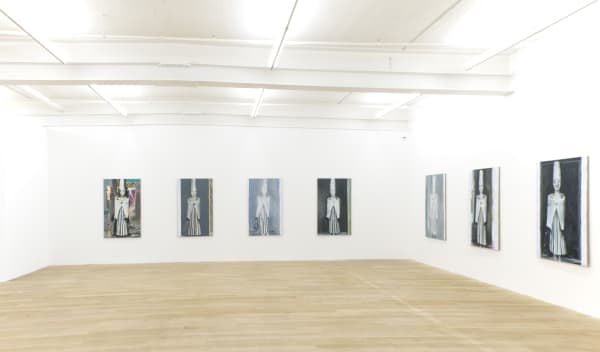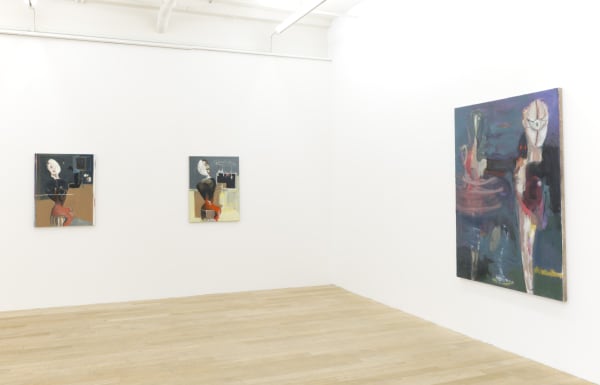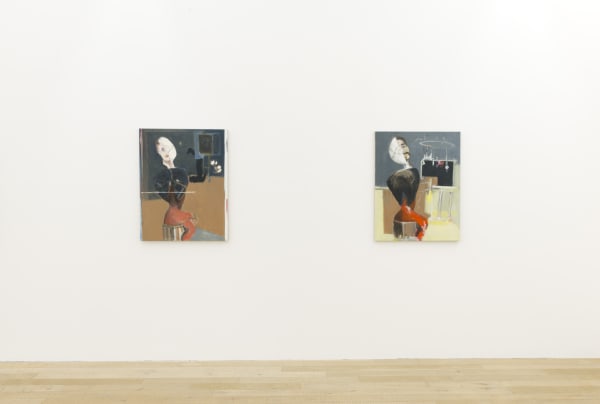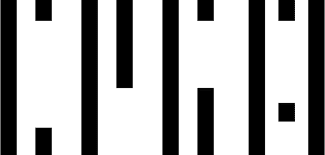"Valérie Favre makes herself a cubist costume out of cardboard and has herself photographed. Based on this photograph, she paints a cycle of eight self-portraits. This is the first time that the artist has made self-portraits the subject of her paintings. She was in turn inspired by a famous photograph taken in June 1916 at the Cabaret Voltaire in Zurich: Hugo Ball, standing in front of music stands, wearing a homemade, magical bishop's costume, reciting his sound poems, which renounce any sense of words with lusty seriousness. The Cabaret Voltaire is the birthplace of DADA, the artistic movement that sought to shatter the economistic-rational mindset from which the First World War had grown. Valérie Favre chooses for her series the dimensions of Marcel Duchamp's famous Nu descendant un escalier n°2 with 146 x 89 cm and thus brings another weighty godfather of the early 20th century into play. The artist spreads several brushes from her right hand in these self-portraits, which clearly characterize her as a painter, unlike the magical Bishop Hugo Ball. If one lets one's gaze wander over the variations of the portraits, one notices that the same figure, but not the same being, looks out at one from each picture: Sometimes the chiaroscuro contrast is strongly pronounced, allowing an angular, androgynous face with piercing eyes to emerge; at other times, the application of color matter and the finely placed contrasts, as well as the dramaturgy of the light, cause the face to appear softer, more shadowy, or more fragile. Photography can claim to depict optical reality exactly. In this portrait series, however, the physiognomic resemblance to the original does not seem to play a superficial role. Valérie Favre is concerned with something else - with an elementary question: What can painting do that no other medium or artistic technique is able to make visible? What is it that is so special about painting, which has repeatedly been revealed in the course of thousands of years of art history, and what role does the artistic subject itself play in this?
While recently it was Goya or Rembrandt whom the painter questioned in her pictorial inventions, now the protagonists of DADA and Surrealism cross her path. They are male companions from the past century, into whose roles she slips or with whose pictorial inventions she plays. Valérie Favre meets them at eye level. The meaning of gender is mixed in with the countless parameters that make up human identity. The artist takes her seat in Giorgio de Chirico's painting Le Vaticinateur from 1915. In place of the armless mannequin, the painter places a creature, itself armless, half of whose face bears the features of a bearded man. The upper part of the body is fleshy. De Chirico's ship's bottom folds upward like a garden fence. It limits the depth of the room and also the black-grounded image in the painting, which in Valérie Favre's work is clouded by pastel mists of color. The artist as a metaphysical half-man with green skin and black chest. A waiting and at the same time prophesying pose that seems to evaporate in the powerful strokes of the brush. De Chirico is also the inspiration for the two paintings L'Amour Fou. The formal constellation is based on de Chirico's Hector and Andromache of 1912: Two mannequins, facing each other, unable to embrace because of their dismembered limbs. The title, in turn, refers to André Breton's novel of 1937, in which he puts into law the contradictions of the most intimate experiences of love. In the painter's work, too, two ovals of the head become visible, leaning toward each other. An apparatus of forms and color surfaces emerges, which mechanically tries to embrace itself. The gray penetrates the forms from the outside. The motivic borrowing from de Chirico and the insoluble theme of absolute love resonate like premonitions in space. Painting and motif merge.
The third appropriation Valérie Favre shows in the exhibition aims at the winged creatures of the symbolist Odilon Redon. The small self-portrait as an angel-man, measuring 24 x 30 cm, also corresponds to the original format of Redon's L'Homme ailé of 1840. Dressed in black and with wings attached, the artist steps out of a blue cloud of color from the right into the sky. It is not certain that these wings are suitable for flying, especially since straps are visible around the shoulders, as we know them from theater props. The angel with the bearded profile looks forward searchingly, carefully scanning the sky as if he were on unknown territory. The idea of a fallen angel who has defied the celestial order therefore also comes to mind. What does painting have to do with Valérie Favre's identity as a human being, and what light do these self-portraits shed on her role as an artist in society? It is the same lustful earnestness with which Hugo Ball recited his sound poems in the magical bishop's costume that prompts Valérie Favre to the self-questioning that at the same time touches on the existential question of painting."
- Katrin Dillkofer
 Valérie FavreSelf-portrait after Hugo Ball, Cabaret Voltaire, Zurich (1916) (I), 2017Oil on canvas146 x 89 cm (57.5 x 35.0 in.)
Valérie FavreSelf-portrait after Hugo Ball, Cabaret Voltaire, Zurich (1916) (I), 2017Oil on canvas146 x 89 cm (57.5 x 35.0 in.) Valérie FavreSelf-portrait after Hugo Ball, Cabaret Voltaire, Zurich (1916) (VI), 2017Oil on canvas146 x 89 cm (57.5 x 35.0 in.)
Valérie FavreSelf-portrait after Hugo Ball, Cabaret Voltaire, Zurich (1916) (VI), 2017Oil on canvas146 x 89 cm (57.5 x 35.0 in.) Valérie FavreHugo Ball, 2017 - 2019Oil on canvas146 x 89 cm (57.5 x 35.0 in.)
Valérie FavreHugo Ball, 2017 - 2019Oil on canvas146 x 89 cm (57.5 x 35.0 in.) Valérie FavreSelf-portrait after De Chirico, Le Vaticinateur, 1915 (female), 2017Oil on canvas90 x 70 cm (35.4 x 27.6 in.)
Valérie FavreSelf-portrait after De Chirico, Le Vaticinateur, 1915 (female), 2017Oil on canvas90 x 70 cm (35.4 x 27.6 in.) Valérie FavreL'Amour fou (2), 2017Oil on canvas160 x 110 cm (63.0 x 43.3 in.)
Valérie FavreL'Amour fou (2), 2017Oil on canvas160 x 110 cm (63.0 x 43.3 in.) Valérie FavreL'Amour fou (1), 2017Oil on canvas170 x 130 cm (66.9 x 51.2 in.)
Valérie FavreL'Amour fou (1), 2017Oil on canvas170 x 130 cm (66.9 x 51.2 in.) Valérie FavreGhost (nach Goyas Hexenflug), 2016Oil on canvas43 x 30.5 cm (16.9 x 12.0 in.)
Valérie FavreGhost (nach Goyas Hexenflug), 2016Oil on canvas43 x 30.5 cm (16.9 x 12.0 in.) Valérie FavreGhost (nach Goyas Hexenflug), 2016Oil on canvas50 x 40 cm (19.7 x 15.7 in.)
Valérie FavreGhost (nach Goyas Hexenflug), 2016Oil on canvas50 x 40 cm (19.7 x 15.7 in.) Valérie FavreGhost (nach Goyas Hexenflug), 2016Oil on canvas50 x 40 cm (19.7 x 15.7 in.)
Valérie FavreGhost (nach Goyas Hexenflug), 2016Oil on canvas50 x 40 cm (19.7 x 15.7 in.)


















